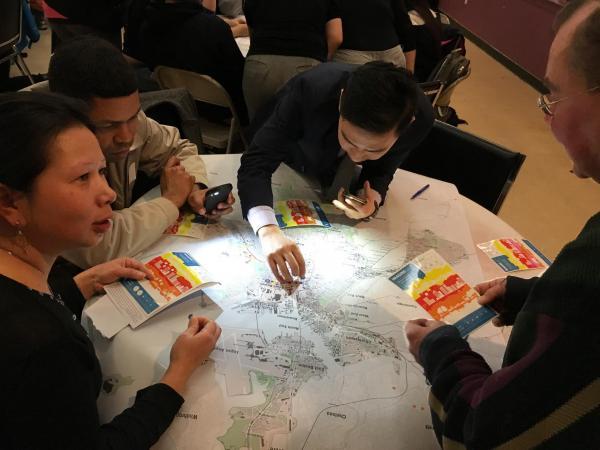March 21, 2016

Residents huddled at a Fields Corner community center for an Imagine Boston 2030 meeting last week. Jennifer Smith photo
The city solicited input for its Imagine Boston 2030 plan from residents at community workshops in Mattapan and Dorchester last Monday. Attendees answered the call by identifying areas in need of housing, transportation, and investment.
Another two Dorchester meetings will take place early this week: Monday, March 21 at the Catholic Charities Teen Center at St. Peter's, and Tuesday, March 22 at the Richard J. Murphy School. Both will last from 6 p.m. to 8 p.m.
Imagine Boston is in the second stage of an extended citywide planning initiative, with the final form expected to be rolled out next spring. A draft of the strategic vision city incorporating feedback from the community workshops is expected to be released in the next few months.
The top three priorities that arose at earlier discussions are intuitive, said John FitzGerald, deputy director of Imagine Boston 2030. Residents asked for housing they can afford, better transportation options, and better education for all. “Now the question is where,” FitzGerald said at the start of the meeting in Dorchester on March 14.
About 40 people gathered in the Viet-Aid auditorium, clustering around eight circular tables featuring maps of Boston. Attendees were asked to place stickers on the large maps to mark where they currently live, work, and play. They added colored stickers to indicate where they would like to live, work, and play. The groups brainstormed proposals for improvements to infrastructure and possible locations for new housing and transit.
At a table in the back, Vietnamese liaison Khoa Pham guided Vivian Veth, Junior Pena, and Hancock Street Civic Association president Bob Mickiewicz through the exercise. When identifying future locations, business owners Veth and Pena homed in on upcoming developments, such as DOT Block in Glover’s Corner, and Boston Redevelopment Authority planning initiatives like the Dorchester Avenue Corridor from Andrew Square to Broadway Station in South Boston.
“Anywhere you have new development coming in, you’re going to see a spike in economic growth,” Pena said. “People are gravitating toward toward [the development sites]. I think that creates more opportunities for the entire population.”
Those at the table shied away from living deep in South Boston or downtown. Transit improvements and potential new housing notwithstanding, “If we cannot afford it now, how are we going to afford it later?” Veth wondered. She and Pena own Landmark Unlimited Realty and Kim’s Flower Shop in Fields Corner.
Most groups identified clusters for housing and transit in Dorchester neighborhoods, although the spread varied significantly between tables. Some eyed areas of Allston, South Boston, East Boston, and downtown. They proposed new transit stops along existing lines and asked for more programming around public open space and parks.
“Our neighborhoods are in relatively good shape,” said Matthew Littell, a principal at the architecture and planning firm Utile Inc. However, he added, “If you feel that your Boston is getting more crowded, it is.”
The Imagine Boston conversations acknowledge the strains of a growing city and high housing costs. Boston’s population grew by almost 40,000 people (6 percent) between 2010 and 2014, and 46 percent of Bostonians are housing-cost burdened, paying more than 30 percent of their income for living space.
Topics:



